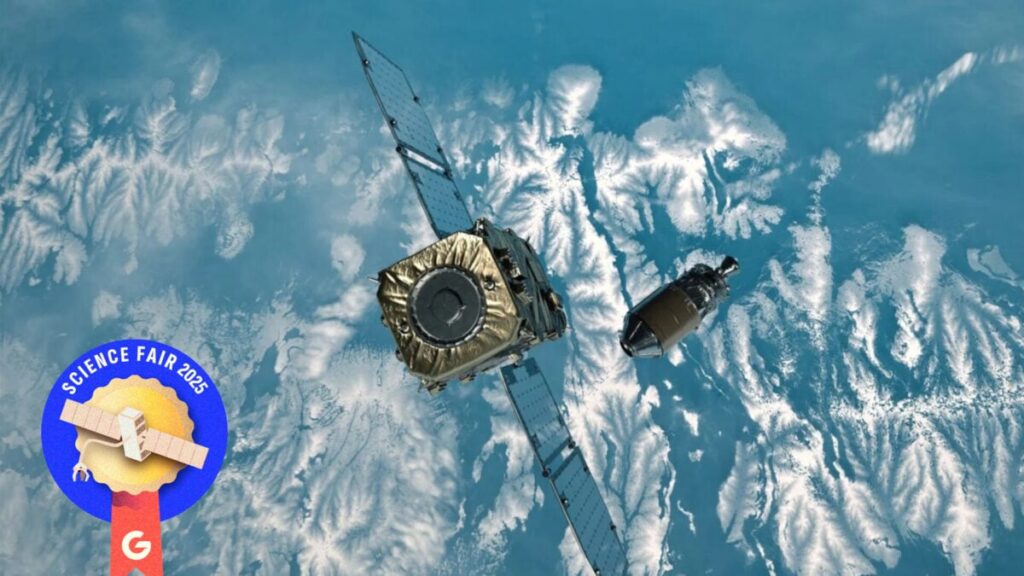Astroscale is a 2025 Gizmodo Science Fair winner for developing a satellite designed to rendezvous with space junk, with the goal of capturing it and guiding it toward a fiery grave in Earth’s atmosphere.
The question
Can the space industry develop new technologies that help tackle the growing problem of debris and create a more sustainable orbital environment?
The results
On February 18, 2024, Astroscale launched its ADRAS-J (Active Debris Removal by Astroscale-Japan) mission on board Rocket Lab’s Electron rocket. The goal of the mission was to demonstrate its ability to approach, observe, and characterize a defunct spacecraft.

The mission target was Japan’s H-2A rocket’s upper stage. This chunk of space junk has been in orbit for nearly 15 years, measuring approximately 36 feet long (11 meters) and weighing 6,613 pounds (3 tons). “Early in the program, we had a whole list of candidates,” Hisashi Inoue, chief engineer at Astroscale Japan, told Gizmodo. “We picked the target that wasn’t farthest away, and we also had some ground observations and information on the target and how it’s behaving.”
Around three months after its launch, the ADRAS-J mission came within nearly 50 feet (15 meters) of the defunct rocket stage. With its unprecedented close approach, Astroscale became the first company to approach a large piece of space debris. It was a challenging feat, Inoue explained, as the debris is flying in space at a speed of 4 miles per second (7 kilometers per second), or faster than the speed of a bullet.
As opposed to other rendezvous missions, the company could not communicate with the defunct rocket part. “This is junk, it’s not telling us where it is or how it’s moving,” he said. “So that makes it more complicated than just talking with a cooperative client.”
Since its target is not equipped with GPS, the ADRAS-J spacecraft had to rely on limited ground-based observations to locate and rendezvous with the spent second stage. Despite the challenges, the satellite was successful in creeping up on its target and performing a fly-around to capture images and data of the upper stage.
ADRAS-J served as a demonstration mission, paving the way for a follow-up that will attempt to remove the debris for real. For Astroscale’s second mission, the satellite will attempt to match the tumble rate of the wayward rocket, align itself, and dock with it. Once it’s docked, the satellite will grab the rocket with a robotic arm and lower its orbit using its thrusters before releasing it on a trajectory toward Earth’s atmosphere. The decommissioned vehicle will then burn up in Earth’s atmosphere, putting an end to its stint in orbit.
Why they did it
Millions of pieces of space debris are currently flying in Earth orbit, with roughly 1.2 million of them larger than 0.4 inches (1 centimeter), according to a recent report by the European Space Agency. That’s large enough to cause catastrophic damage to other spacecraft if it collides with them.
“If you think about the terrestrial auto industry, there are all these different services performed after the car is used by the first person. It’s reused, refurbished, or recycled, and goes to second-hand use,” Inoue said. “But in space, you use [a spacecraft] once and you throw it away, but that’s not good for sustainability.”
Nobu Okada founded Astroscale in 2013, focusing on orbital debris removal and in-orbit satellite servicing. The Tokyo-based company aims to reduce the growing amount of space junk not only by physically removing defunct spacecraft but also by extending the lifespan of satellites in space.
“By combining all those things, I don’t think we, as Astroscale itself, can change the world’s sustainability, but we’re hoping this will kind of jump-start some of the servicing-type missions, and customers will endorse this way of thinking,” Inoue said. “Hopefully in the future, this will connect to sustainable use of space.”
Why they’re a winner
At a time when space startups are focused on launching more satellites, spacecraft, and rockets into orbit to cash in on the commercial use of space, Astroscale is one of the few companies promoting a sustainable practice that will allow others to coexist in the orbital environment.

The company is not only aiming to remove orbital debris but also to enable satellite inspection, relocation, refueling, and other life-extension services. Astroscale is pioneering sustainable use of Earth orbit in hopes that other companies follow suit and that governments worldwide set requirements for the use of space.
What’s next
Astroscale’s upcoming satellite is set for launch sometime in 2027, taking all the data and lessons learned from ADRAS-J and applying them to the follow-up mission.
ADRAS-J2 is designed to actively remove the defunct Japanese rocket from orbit using Astroscale’s in-house robotic arm technology to capture it and lower its orbit. “We’re currently in the design phase,” Inoue said. “Eventually we’ll start getting more hardware in the lab and start testing it, and then start building the spacecraft next year.”
The team
Key members of the Astroscale team include Nobu Okada, founder and CEO; Chris Blackerby, chief operating officer; Mike Lindsay, chief technology officer; Nobuhiro Matsuyama, chief financial officer; Melissa Pane, mission and system engineer; Arielle Cohen, flight software engineer; and Gene Fujii, chief engineer.
Click here to see all of the winners of the 2025 Gizmodo Science Fair.


